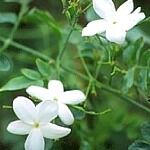| Common Name: |
Jasmine |
| Botanical Name: |
Jasminum grandiflorum |
| Family: |
Oleaceae |
| Location: |
United States, China, India, Egypt, France, Italy, Morocco, Turkey |
| Extraction: |
Solvent |
| Parts Used: |
Flowers |
| Color and Odor: |
The absolute is a deep reddish-brown in color and has a warm, sweet, exotic, slightly heady aroma with a hint of musky undertones. |
| Background: |
Long used in China as a perfume and for scenting tea. It is fashionable for Chinese girls to wear jasmine flowers in their hair. Jasmine is also important in the Hindu and Muslim traditions, and was introduced by the Moors to Spain. Used in Malaya for fevers. Jasmine is now one of the most expensive perfume ingredients. |
| Properties: |
Sedative, uplifting, antidepressant, antispasmodic, aphrodisiac |
| Planet: |
Moon |
| Element: |
Water |
| Direction: |
West |
| Magical Influences: |
Love, Peace, Spirituality, Sex, Sleep, Psychic dreams |
| Uses: |
- Reproductive System—Relieves uterine spasms and menstrual cramps. Very useful during childbirth.
- Skin—Good for dry sensitive skin, especially when there is redness. Jasmine also increases skin elasticity.
- Emotions—Dispels apathy, indifference and listlessness, producing feelings of optimism, confidence and euphoria. It releases inhibitions, liberates imagination and is exhilarating. Jasmine powerfully provokes fantasies, lifting the darkest moods and bringing out inner desires. It is beneficial for postnatal depression. Jasmine is a known aphrodisiac.
|
| Blends: |
| REPRODUCTIVE |
SKIN |
EMOTION |
| Jasmine 5 |
Jasmine 3 |
Jasmine 4 |
| Geranium 3 |
Lavender 2 |
Mandarin 4 |
| Marjoram 2 |
Chamomile (R) 2 |
Sandalwood 3 |
| Bibliography: |
Aromatherapy Blends and recipes by Franzesca Watson Copyright © 1995 Thorsons, Harper Parker Publishing Inc. Pp 114-115
Magical Aromatherapy by Scott Cunningham Copyright © 1989 Llewellyn Publications, Inc. Pp. 98-100 |
|

